|
by special BMR Italian Movie CorrespondentMarc C. BeschlerThe world of cult film is wild and diverse, undoubtedly one of the reasons we love it so much. From black and white visions of a future that came and went without ever actually arriving to tales of the walking dead chowing down on the hapless living. From Mexican wrestlers who moonlight as superheroes to sordid stories of chicks in chains. From arch, veddy British renditions of classic monsters to bizarro pastiches of the most disgusting and perverse people in cities ranging from Madrid to Baltimore. Stone-age cannibals, samurai warriors, sexy nuns, slimy aliens…hell, I could go on and on. As you walk down these many paths, you're going to find things that you like, things that you don't like and some things that dance around in the middle back and forth over the dividing line of indifference. For example I as a cult film enthusiast (and I realize this is tantamount to a sex addict confessing he doesn't enjoy being fellated) have never been all that crazy about kung fu movies. Don't dislike'em, just prefer'em in controlled doses. Many things in life are a matter of taste and in cult film matters of taste (or in some cases the lack thereof) are often defining factors. As cult film itself is not for everyone, so a particular subdivision of it, for our purposes we will choose Italian genre cinema, may not be for all cult enthusiasts. Going even further within the framework out of all the fans of Italian genre cinema, some will be enamored of the giallo, some will not. And to take this to the next annoying level, even within that group of giallo devotees, there are going to be divisions. For devotees of bare-breasted European actresses, there's the T&A tack of such films as Sergio Martino's flawed but interesting Torso or Piccio Raffanini's nudes-a-plenty but god-awful Obsession: A Taste for Fear. Some may find the 'brutality for brutality's sake' approach of the like of Lucio Fulci's The New York Ripper and Mario Landi's Gore in Venice to be crude and unappealing, particularly when compared with the comparatively elegant approach of Dario Argento or, say, Pupi Avati. And of course for the exact same reasons some are going to prefer the type of films that Fulci and Landi have made. This is one of the things that keeps cinema interesting. "Variety is the spice of life" and all that. And the punchline is that I'm not sure I could say
which of these groups Armando Mimsy Farmer plays Simona, a morgue doctor writing a thesis on the difference between actual suicides and murders made to look like suicides. Our Mimsy appears to be well on her way towards mental collapse from the very beginning of the film, particularly inasmuch as she hallucinates in the first scene that the corpses in the morgue are coming to life, two of them even attempting to have sex. Talk about women on the verge of a nervous breakdown, huh? And yet, later on in that same scene, her colleagues play a joke on her by having a friend of hers' pretend to be a dead body. He leaps up at her when she pulls back the sheet, and while she does admittedly get upset, her reaction is actually rather understated (considering the visions she was just having I would have expected nothing less than complete apoplexy). They might have elicited a not dissimilar reaction if they had chosen to, say, hit her in the face with a pie. But then I guess that kind of humor might seem out of place in a morgue. Moving right along… Our Mimsy shows even more aplomb in the following
scene when her friend Ed (Ray Lovelock, the 'corpse' from After leaving the scene of the attempted grope, she goes upstairs to her apartment. As she leafs through photos of murder scenes (some people read John Grisham to relax, others…), a knock comes at her door. It turns out to be a young woman named Betty (Gaby Wagner), staying in Mimsy's father's apartment upstairs. Betty asks if she can borrow an envelope for a letter she has to mail. As Simona gets her one from a box of orange-colored envelopes, they engage in conversation. To Mim's surprise, the girl claims not to know Dad, saying that she is an American touring Europe, that she was given a key to the place by a friend and that she's headed back to the US the next day. The girl sees the autopsy photos and disgustedly asks "Don't tell me you get your kicks from this stuff!" to which our Mimsy icily, but again with that remarkable poise, assures her that her interest is strictly professional. The girl seems nervous about something, but before Mim can get any details, they hear the phone ringing in the upstairs apartment. The girl goes to answer. She dismissively blows the caller off, hangs up and then runs out of the building. In quick succession, she sees the building's caretaker with his dog, has a run-in in an alley with a pervo who tries to feel her up and who is accompanied by a transvestite who looks remarkably like Ruth Gordon (Let's see RuPaul pull off that look!), meets with a priest in church and is finally approached by a car. She takes one look at the car's occupant, says "It's you again"…BANG! Suddenly it's the next day and she's lying dead on the beach, her pretty face somewhat mangled, the victim of an apparent suicide.
Simona sees the girl's body in the morgue and, despite different color hair and the protruding eyeball, thinks she recognizes her. She goes off to see her father, leaving her creepy assistant to reconstruct the girl's face, though he apparently thinks that she's there for a tit job, as he immediately begins fondling her. Simona meets her father at a pool and after a greeting laced with wacky incestuous implications, he tells her that he's engaged to be married. He says that his fiancée is supposed to meet them but for some reason hasn't shown up yet. Simona, sharp little cookie that she is, begins to suspect that his betrothed is in fact the girl she met the previous night. Since she also suspects that this may be the girl lying on the slab at work, she gets a little freaked and makes a hasty departure. On her way out she runs into an acquaintance, Daniella, an artist who specializes in death-themed art and who is putting together a new exhibit. Simona notices that Daniella is wearing a wig, which sparks in her mind that the girl from the night before may have been wearing one as well. She runs out. Her father comes in and speaks to Daniella, leading to what is probably my favorite exchange in the film and a good example of that patented, giallo-style of "Come again?" dialogue:
Simona and Lenox get in her car to drive to the scene of the crime. He mentions that she looks nervous, though she would seem to have every reason to be, as his driver's ed apparently consisted of repeated viewings of The French Connection. He wants her to help him go over the crime scene, but she blows him off. She comes upon Ed taking pictures and they decide
to go up to his place. Viewers might expect a seduction scene to
follow, but as the two of them pretty much jump into bed immediately,
they'll be disappointed - much like Ed is, as Simona begins having
visions of reanimated corpses again. This pretty much kills the
mood, so he gives her a tour of the place instead. He has a collection
of old books, which she remarks that her father would love. She
apologizes for her little freak-out, but he blames her work:
This segues into a conversation about Ed's love of car racing, during which he hypothesizes that Father Lenox may be an ex-race car driver who had a terrible accident, which resulted in numerous fatalities and the committal of the driver to a mental institution. Simona protests:
(It actually took me a couple rewinds to get this last phrase exactly. I couldn't quite glom the last word, thinking it to be by turns 'loopy', 'loogy' and even 'Luigi' at one point, before finally detecting the 'n'.) Simona goes back home. Outside she kneels down and pets the caretaker's dog, a nice, innocent little moment amidst all the depravity that pretty much ends when she catches him looking up her skirt (the caretaker, not the dog). Lenox shows up with a bracelet he found at the crime scene, which he claims proves someone else was involved in his sister's death, implying that it may have been Simona's Dad. She does not take kindly to this and accuses him of not being a real priest, which means it's now his turn to get offended. Yelling that he is a real priest, he shakes her like an Etch-a-Sketch and throws her forcefully onto the couch, which suggests that he may have gotten his clerical schooling at Torquemada Memorial Seminary. He runs outside, jumps into a cab and proceeds to have an epileptic fit. He's taken back to the church, where he takes medication and passes out.
Meanwhile the slob caretaker is beating his dog in his flat. He pauses to relieve himself in the bathroom. The dog begins barking at someone entering the apartment. Simona hears the dog and enters the apartment herself. She goes into the bathroom where she finds the caretaker hanging from the shower by his belt. Simona screams, bringing Lenox conveniently rushing in. He pulls the man down and tries to revive him, but it's too late. When questioned the caretaker's wife claims that there is every reason to believe it was a suicide, but what are the odds that that's going to turn out to be the case? Slim and none, as Lenox immediately discovers a check made out to the caretaker by Simona's father for an inordinately large amount. This convinces him that Simona's father killed his sister and paid off the caretaker who must have witnessed something, but Simona still insists that it can't be. For some strange reason, Simona then goes to the museum where Daniella is putting together her latest exhibit, a gruesome gallery of photos of decomposing corpses and other children's fare. Daniella, despite her peculiar brand of aesthetics, sees fit to call Simona sick in the head, asking her if she's come to the exhibit to "get ideas." Simona responds by calling her a lush and running away. Passing more nasty pictures, she comes to a room marked '13,' from which a sound somewhere between sobbing and moaning is coming. Naturally, given the success rate of her previous investigative efforts, coupled with the number 13's traditionally lucky association, she opens the door. Inside she finds an exhibit of wax figures in various scenes of violent death. (What kind of morbid f*cking museum is this anyway? Actually I went to one kind of like it in Coney Island once, but it's probably not the same one.) One of the figures is an attempted suicide with a
note pinned to his chest and a Ed comes to visit Simona where Lenox is looking after her. He recognizes Lenox as indeed the former racecar driver that he thought he might be. He invites the two of them to come see him race. He also urges Simona to drop the suicide study, at least for a while:
To celebrate his near death experience, Ed takes Simona back to his place again for a drink where she meets his elderly aunt, who is deaf as a post, which probably makes being around him easier. Shuffling Auntie back into her box, Ed and Simona sit making goo-goo eyes at each other. She tells him how much her feelings for him have grown and he responds with the classic romantic move of showing her a dirty slide show. The pictures are from some Parisian brothel and rather than smack the beard off his face, Simona starts to get into it, even saying that she would have liked to have been one of the hookers in the photos. (As they used to say on MST3K, I think the screenwriters may have had issues with women.) She starts, let us say, "doin' a thing" on him, while more pictures play on the wall behind them, including two surprisingly explicit ones that are most likely fake. The shock that some smutty slides could make Simona get all hot and bothered is immediately tempered by the familiarity of how quickly she ruins her own mojo by freaking out, muttering something about "it can't be," which is what Ed must be thinking about their chances of ever getting it on. He suggests that maybe if they took a trip together she would "loosen up," which I think is being extremely kind. Simona's father calls her at Ed's, telling her that
he saw them together and that he has to talk to her immediately.
He tells her that Dad returns to the apartment building and finds his brother going through his bookcase, though he claims he's just 'straightening up.' He gives Dad the orange envelope from before. In the letter, Betty apologizes for having run off and for having stolen a document, which she says is enclosed with the letter. Only problem is it's not enclosed, Dad accuses his brother of taking it and a struggle ensues. Mimsy, riding in a cab and daydreaming images of her father and Betty making it alternated with the dead girl lying on the slab, arrives at the building and goes inside just in time to not see her father fall out of the window and go kerplunk on the sidewalk. An abrupt cut takes us to the hospital where Simona, her uncle and Daniella are in the waiting room. Uncle claims he just got into town, but Simona calls him a liar. The doctor informs them that Dad should live, but will be paralyzed. We cut to Ed, having a largely one-sided conversation with his deaf aunt, in which he mentions his frustration with his deceased father's tricks, most notably the fact that he had hidden his will in an old Bible. Back at the hospital, Lenox shows up to comfort Simona,
but she won't have any of it: "We don't need any priests here!"
Whew! This is the first time I've ever tried to write such a detailed plot synopsis for a review and I've got to say that I don't know how the good Dr. does it every week (save perhaps for his confessed jones for typing out 'The End' when he's done). Thankfully I think it's time for me to stop as going any further would most likely give away the identity of the murderer, so let's just talk about the film a little bit and then I'll shut up. Die-hard giallo fans may disagree, but it seems to
me that many of them (the films, not the fans), even some of the
best, are at their base not really much more than tarted up slasher
flicks. Admittedly the tarting up can work wonders, giving them
a degree of watchability that is absent from a great deal of other
slasher films, provided of course that you don't mind not knowing
at any given moment what exactly the f*ck is going on. The accent
on atmosphere in these films is a double-edged sword. Just as easily
as it can mesmerize some, it can alienate others. I have discussed
with a number of people, the good Dr. included, both the virtues
and fallbacks of Italian genre cinema in general and on the negative
side, it always comes down to the same thing. A film without a solid
story is basically just a series of scenes, hopefully linked together
by some sort of premise, but basically existing in and of themselves
because the filmmakers thought each one would look cool. (Note for
example the StompTokyo
review of Fulci's Zombie in which they cited the shark-fighting
scene as being solely responsible for them giving the film a rating
of three. The scene comes out of nowhere and doesn't really make
any The question then is to what degree can a film ride on 'cool' alone? And to what degree does this rather dubiously imply that good old-fashioned storytelling techniques are somehow 'uncool?' How can we tell when a director is bombarding us with smoke and mirrors because he thinks it best serves the film and when he's doing it because ultimately he just doesn't give a rat's ass? One might think it would be easier to answer this question when looking at the work of individual directors, but even in this arena there is much debate. Plenty of people will tell you that Argento and Fulci are both geniuses, but there are plenty of others who see it all as a lot of stylistic tricks, masking an inability, or at the very least an unwillingness, to tell a solid story. Personally I don't really believe this, though I admit that when talking about a film like, say, The Beyond, which I believe to be a truly great exercise in horror, I find it easier to use a word like 'masterpiece' when I think of it in contrast to, say, Bruno Mattei's Night of the Zombies. And to carry this mad tangent even farther, I am forced to admit that I know very little about Bruno Mattei. For all I know, he may be the spaghetti splatter version of Ed Wood, a man with a tremendous enthusiasm to make good films, who just doesn't have the chops it requires (I doubt that this is the case, but then again, his spag western Scalps wasn't half bad). Before I drag a whole other genre into this mess, I'll just say that, yes, taste in film is still an extremely subjective thing, a matter of having an eye for certain aesthetic qualities, yada yada yada. Now let's see if I can find my way back to the point I was making about an hour ago.
Lenox displays his contempt for the crowd at the racetrack with their thirst for violence and, of course, he knows whereof he speaks. He used to be a part of that world and was himself responsible for the violent deaths of innocent people. It was an accident of course, but apparently affected him to the point that he felt he had to take vows. For most of the film it's hard to figure out exactly
where Ed stands. He seems to bounce back and forth between making
cavalier jokes like the "we'll all commit suicide" line and scolding
Simona like a parent for her disturbing obsession. This is all the
more freaky considering he spends the rest of the time trying to
get into her drawers (and I'm not talking about the ones at the
morgue, And then there's our Mimsy (had to slip one more in). The majority of Italian genre films in general and gialli in particular are not exactly known for their liberated views of womanhood. Women are often the main characters and are even shown asserting their independence with surprising frequency (the little darlings!), though this is just as frequently undercut by the inevitable reliance on a man to "rescue" them or "set them straight" as to their true position in the scheme of things. And I'm not even going to bother getting into the possible implications of filmmakers who would include scenes like New York Ripper's infamous razor blade/nipple sequence. Farmer's Simona bounces back and forth between shows of strength and weakness throughout the film. She steadfastly maintains her belief in her father's innocence, yet continuously gets sidetracked by her all-consuming obsessions (namely death, sex and, to a lesser degree, Ed, in that order and sometimes all within the same scene). This makes it a bit harder to pinpoint the filmmaker's intentions towards her character, though the fact that her defining scene with Ed, as described above, presents her stripped naked in front of a mirror (and the fact that, not to give away too much, a man does end up saving the day) tends to indicate that things are pretty much business as usual here. But that's not necessarily a conscious choice on Crispino's part as, once again, it is Simona's obsessions that he chooses to define her character by. So while she certainly wouldn't be voted a role model at any NOW meeting, she is at least an interesting character, much more so than the "helpless victims" often used for this kind of film. Having
RATING:
A strange example of a strange genre. - July 1, 2001
|
||||||
|
|
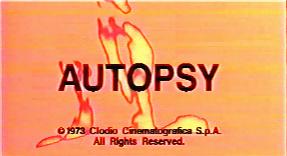
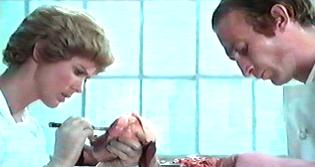 Crispino's Autopsy would appeal to more. While largely avoiding
the bloody theatrics characteristic of so many examples of the genre,
it has a pervading atmosphere of violence that may leave viewers
with an impression of having seen something far more brutal than
they actually have. (Oh yeah, and there's lots of nudity.) From
the opening montage of ugly death scenes (somewhat of a mislead,
given what is to come) set to a funky tune by cult fave composer
Ennio Morricone, it is already apparent that this is not going to
be an ordinary thriller. In fact the film manages to conjure an
energetic mix of the strange and the (shocking/distasteful/perverse,
take your pick, they're all in there) that is so aggressive as to
set it apart even in the unusual world of gialli.
Crispino's Autopsy would appeal to more. While largely avoiding
the bloody theatrics characteristic of so many examples of the genre,
it has a pervading atmosphere of violence that may leave viewers
with an impression of having seen something far more brutal than
they actually have. (Oh yeah, and there's lots of nudity.) From
the opening montage of ugly death scenes (somewhat of a mislead,
given what is to come) set to a funky tune by cult fave composer
Ennio Morricone, it is already apparent that this is not going to
be an ordinary thriller. In fact the film manages to conjure an
energetic mix of the strange and the (shocking/distasteful/perverse,
take your pick, they're all in there) that is so aggressive as to
set it apart even in the unusual world of gialli.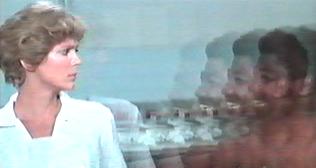 the
previous scene) drives her home. As soon as they arrive at her building,
he stops the car and tries to molest her, which she responds to
with a playful "Oh, you!" attitude, a rape whistle perhaps not being
handy at the time.
the
previous scene) drives her home. As soon as they arrive at her building,
he stops the car and tries to molest her, which she responds to
with a playful "Oh, you!" attitude, a rape whistle perhaps not being
handy at the time. But
wait! Could this possibly lead to our Mimsy suspecting that the
suicide is actually staged and that what we've really got here is
a murder? JUST LIKE HER THESIS?! Dear reader, you can be as sure
of that as you can be sure that I love saying "our Mimsy" (which
for the sake of your sanity and mine, I will now stop doing; for
the remainder of this review, I'll use the character's name, which
was again…anyone? anyone? (Sigh.) Simona. Really, people, you're
going to have to do better than that).
But
wait! Could this possibly lead to our Mimsy suspecting that the
suicide is actually staged and that what we've really got here is
a murder? JUST LIKE HER THESIS?! Dear reader, you can be as sure
of that as you can be sure that I love saying "our Mimsy" (which
for the sake of your sanity and mine, I will now stop doing; for
the remainder of this review, I'll use the character's name, which
was again…anyone? anyone? (Sigh.) Simona. Really, people, you're
going to have to do better than that).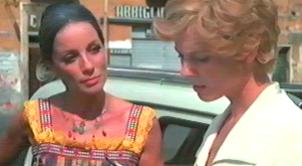 The
coroner catches Simona in the morgue trying a red wig on the body,
though that's likely the least offensive thing that the poor girl
has been subjected to while in their care. The authorities have
definitively ruled it as a suicide, dismissing Simona's speculations
of murder, but another voice joins in: Father Lenox (Barry Primus),
the priest that we saw the dead girl with shortly before her death,
comes in saying there's no way she would kill herself. He knows
this because not only was he her confessor, he is also her brother!
(Can't you just hear the organ music swelling?)
The
coroner catches Simona in the morgue trying a red wig on the body,
though that's likely the least offensive thing that the poor girl
has been subjected to while in their care. The authorities have
definitively ruled it as a suicide, dismissing Simona's speculations
of murder, but another voice joins in: Father Lenox (Barry Primus),
the priest that we saw the dead girl with shortly before her death,
comes in saying there's no way she would kill herself. He knows
this because not only was he her confessor, he is also her brother!
(Can't you just hear the organ music swelling?) 
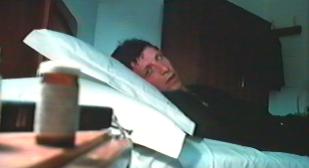 Simona
goes to her Dad's apartment to clean out the dead girl's stuff.
While there she gets a call from her uncle whom she asks about a
letter that may have arrived from the girl. He denies that any such
letter has come, though we the audience can clearly see that he
is holding a very conspicuous orange envelope in his hand. Suddenly
she hears a noise. Peeking around a corner, she sees someone, their
face conveniently obscured, enter the apartment, look through her
father's rare books and, presumably not having found what they were
looking for, leave empty-handed.
Simona
goes to her Dad's apartment to clean out the dead girl's stuff.
While there she gets a call from her uncle whom she asks about a
letter that may have arrived from the girl. He denies that any such
letter has come, though we the audience can clearly see that he
is holding a very conspicuous orange envelope in his hand. Suddenly
she hears a noise. Peeking around a corner, she sees someone, their
face conveniently obscured, enter the apartment, look through her
father's rare books and, presumably not having found what they were
looking for, leave empty-handed.  shotgun
rigged to go off when a string attached to the trigger is pulled.
Simona moves to take a closer look. Behind her someone shuts the
door and locks it. She freaks and tries to open the door, but realizing
she can't get out moves back towards Attempted Suicide. She reaches
for the note on the figure's chest. But wouldn't you know it, right
at that moment someone, having heard her cries, opens the door,
startling her, causing her to bump the figure's hand, pulling the
string, firing the gun, reducing the figure's head to so much goat
cheese and changing the name of the exhibit from Attempted Suicide
to Quite Successful Suicide Thank You Very Much. She then proceeds
to faint in extreme slow motion accompanied by some freaky and frenetic
violin plucking on the soundtrack.
shotgun
rigged to go off when a string attached to the trigger is pulled.
Simona moves to take a closer look. Behind her someone shuts the
door and locks it. She freaks and tries to open the door, but realizing
she can't get out moves back towards Attempted Suicide. She reaches
for the note on the figure's chest. But wouldn't you know it, right
at that moment someone, having heard her cries, opens the door,
startling her, causing her to bump the figure's hand, pulling the
string, firing the gun, reducing the figure's head to so much goat
cheese and changing the name of the exhibit from Attempted Suicide
to Quite Successful Suicide Thank You Very Much. She then proceeds
to faint in extreme slow motion accompanied by some freaky and frenetic
violin plucking on the soundtrack.  At
the racetrack, Lenox muses that this latest incident with Simona
might have been a suicide attempt on her part after discovering
something incriminating about her father. But before he can get
too far with this theory, he leaves, sickened by the blood lust
of the crowd waiting for an accident to happen, which they don't
have to wait too long for as Ed's windshield is shattered by a bullet
and he spins and crashes. From somewhere in the crowd, Dad watches,
scowling, as Simona rushes to see if Ed is all right. He isn't injured,
but she finds that the peril has endeared him to her all the more.
Women.
At
the racetrack, Lenox muses that this latest incident with Simona
might have been a suicide attempt on her part after discovering
something incriminating about her father. But before he can get
too far with this theory, he leaves, sickened by the blood lust
of the crowd waiting for an accident to happen, which they don't
have to wait too long for as Ed's windshield is shattered by a bullet
and he spins and crashes. From somewhere in the crowd, Dad watches,
scowling, as Simona rushes to see if Ed is all right. He isn't injured,
but she finds that the peril has endeared him to her all the more.
Women. 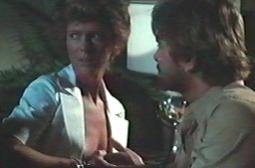 he's tired of hiding and demands that she make some excuse to leave
so that they can meet at the house. Dad goes out and gets into his
car. Surprisingly, to us anyway, Lenox is sitting in the driver's
seat and they proceed to start driving and talking. Dad admits he
was going to marry Lenox's sister, but that she disappeared and
that he hadn't heard anything more about her until she turned up
dead. Lenox says that his sister confessed to him that she had done
something to Dad that she felt guilty about, but never told him
what it was and he believes that this is why she was killed. Dad
still insists it was a suicide. Lenox accuses him of covering for
someone he's scared of and demands to know who and why, but Dad
is not forthcoming.
he's tired of hiding and demands that she make some excuse to leave
so that they can meet at the house. Dad goes out and gets into his
car. Surprisingly, to us anyway, Lenox is sitting in the driver's
seat and they proceed to start driving and talking. Dad admits he
was going to marry Lenox's sister, but that she disappeared and
that he hadn't heard anything more about her until she turned up
dead. Lenox says that his sister confessed to him that she had done
something to Dad that she felt guilty about, but never told him
what it was and he believes that this is why she was killed. Dad
still insists it was a suicide. Lenox accuses him of covering for
someone he's scared of and demands to know who and why, but Dad
is not forthcoming. 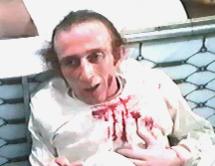 Presumably
to cheer herself up, Simona goes to the morgue to reexamine the
girl's body. She finds a puncture mark, which finally gives her
some solid evidence that there was, in fact, foul play. As a way
of congratulating her for her fine albeit slow-as-sludge detective
work, her creepy assistant tries to molest her. Either owing to
some off-screen female empowerment courses, or possibly due to the
fact that the assistant is not exactly what you would call 'comely,'
she reacts to this molestation attempt in a far more reasonable
way: namely she grabs a fork and starts jabbing him like he were
a cut of prime rib. Ed enters in a timely fashion and prevents her
from ventilating the guy to death, offering this little piece of
giallo-speak to the cowering creep: "You may be an expert
on corpses, fella, but you've got a lot to learn about women!" Whatever.
Presumably
to cheer herself up, Simona goes to the morgue to reexamine the
girl's body. She finds a puncture mark, which finally gives her
some solid evidence that there was, in fact, foul play. As a way
of congratulating her for her fine albeit slow-as-sludge detective
work, her creepy assistant tries to molest her. Either owing to
some off-screen female empowerment courses, or possibly due to the
fact that the assistant is not exactly what you would call 'comely,'
she reacts to this molestation attempt in a far more reasonable
way: namely she grabs a fork and starts jabbing him like he were
a cut of prime rib. Ed enters in a timely fashion and prevents her
from ventilating the guy to death, offering this little piece of
giallo-speak to the cowering creep: "You may be an expert
on corpses, fella, but you've got a lot to learn about women!" Whatever.
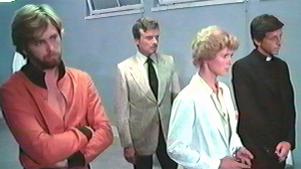 sense
on the whole. It was included simply because someone thought it
would be cool, which in all fairness, it is.)
sense
on the whole. It was included simply because someone thought it
would be cool, which in all fairness, it is.) Oh
yes, the giallo as slasher film. The main difference between
these films and their American counterparts, which of course didn't
really start until the late '70's, is that in most American slashers
its either implicit who the killer is, owing to it being an installment
in a franchise (Freddy, Jason, etc.), or its just painfully obvious
who the killer is from the get-go, while in most gialli should
you find yourself understanding the whodunit aspect of the film,
might I suggest that you go lie down somewhere and wait
to come down from the effects of whatever psychotropic drug you
are currently on. These are general rules, but not all-encompassing
ones, so if you think you know of exceptions, you're right. In fact
you're looking at one right now, which is the whole reason I started
down this road in the first place. Not only is Autopsy not
a slasher film by standard definition, it's not even remotely in
the ballpark. The only actual murder in the whole film takes place
off screen and the most graphic act of onscreen violence is inflicted
upon a mannequin. This is because Crispino
is much more interested in portraying the characters' various attitudes
towards violent death (most especially Simona's fixation with it)
than he is in depicting violent death itself.
Oh
yes, the giallo as slasher film. The main difference between
these films and their American counterparts, which of course didn't
really start until the late '70's, is that in most American slashers
its either implicit who the killer is, owing to it being an installment
in a franchise (Freddy, Jason, etc.), or its just painfully obvious
who the killer is from the get-go, while in most gialli should
you find yourself understanding the whodunit aspect of the film,
might I suggest that you go lie down somewhere and wait
to come down from the effects of whatever psychotropic drug you
are currently on. These are general rules, but not all-encompassing
ones, so if you think you know of exceptions, you're right. In fact
you're looking at one right now, which is the whole reason I started
down this road in the first place. Not only is Autopsy not
a slasher film by standard definition, it's not even remotely in
the ballpark. The only actual murder in the whole film takes place
off screen and the most graphic act of onscreen violence is inflicted
upon a mannequin. This is because Crispino
is much more interested in portraying the characters' various attitudes
towards violent death (most especially Simona's fixation with it)
than he is in depicting violent death itself.  heh,
heh…sorry). And interestingly he eventually does get lucky in a
scene where he tears her clothes off and forces her to look at herself
naked in a mirror, saying that she has forgotten how beautiful she
really is. The nudity aside this is borderline touching, until we
realize that the way she's standing makes her look like a vertical
version of the corpses she studies all day and which seem to invade
her mind particularly when she's getting aroused. That this is what
finally leads to them successfully getting it on (and an earlier
scene where she lies on his bed, ordering him to undress her much
like one would a corpse bolsters the idea that this is what gets
her motor running) just adds to the ickiness factor, but it's also
indicative of the odd nature of their relationship. This relationship
is one of the more interesting aspects of the story and probably
would have been even more so if Ed didn't come off as such a self-absorbed
jerk so much of the time.
heh,
heh…sorry). And interestingly he eventually does get lucky in a
scene where he tears her clothes off and forces her to look at herself
naked in a mirror, saying that she has forgotten how beautiful she
really is. The nudity aside this is borderline touching, until we
realize that the way she's standing makes her look like a vertical
version of the corpses she studies all day and which seem to invade
her mind particularly when she's getting aroused. That this is what
finally leads to them successfully getting it on (and an earlier
scene where she lies on his bed, ordering him to undress her much
like one would a corpse bolsters the idea that this is what gets
her motor running) just adds to the ickiness factor, but it's also
indicative of the odd nature of their relationship. This relationship
is one of the more interesting aspects of the story and probably
would have been even more so if Ed didn't come off as such a self-absorbed
jerk so much of the time. 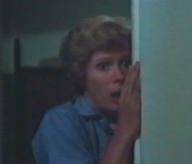 blathered on long enough about Autopsy's social dynamics,
I realize it's time to address one more important point: is this
film at all enjoyable to watch? Going way back to the beginning,
of course it's a matter of taste. Many people reading this already
know whether or not it's the sort of film for them. At the very
least, Autopsy deserves recognition for attempting to expand
beyond the standard 'black-gloved killer'-themed plots of many of
the genre's examples. That it also has so many little moments of
eccentricity is icing on the cake: the quirky giallo-speak;
Farmer's walk through the museum of gruesome images; the dress she
wears that looks like it has nipples of its own; the scene where
she attacks her horny assistant with a fork (prompting the question:
a fork? in the morgue?). These are the kind of idiosyncratic touches
that are prevalent in gialli and go a hell of a lot further towards
explaining why people like them than grandiloquent ideas like Argento's
'beautiful murder' concept or harebrained, needlessly in-depth analyses
of characters such as the one I have just inflicted on you.
blathered on long enough about Autopsy's social dynamics,
I realize it's time to address one more important point: is this
film at all enjoyable to watch? Going way back to the beginning,
of course it's a matter of taste. Many people reading this already
know whether or not it's the sort of film for them. At the very
least, Autopsy deserves recognition for attempting to expand
beyond the standard 'black-gloved killer'-themed plots of many of
the genre's examples. That it also has so many little moments of
eccentricity is icing on the cake: the quirky giallo-speak;
Farmer's walk through the museum of gruesome images; the dress she
wears that looks like it has nipples of its own; the scene where
she attacks her horny assistant with a fork (prompting the question:
a fork? in the morgue?). These are the kind of idiosyncratic touches
that are prevalent in gialli and go a hell of a lot further towards
explaining why people like them than grandiloquent ideas like Argento's
'beautiful murder' concept or harebrained, needlessly in-depth analyses
of characters such as the one I have just inflicted on you.